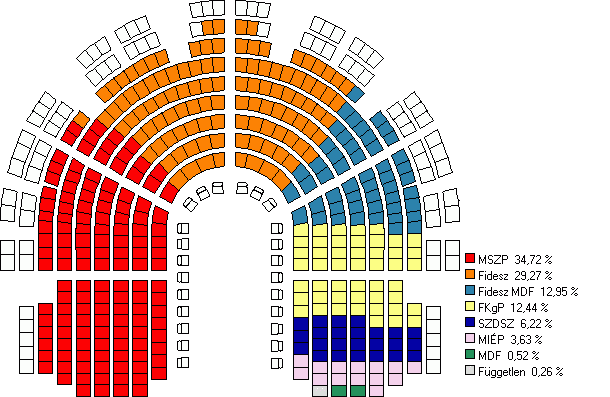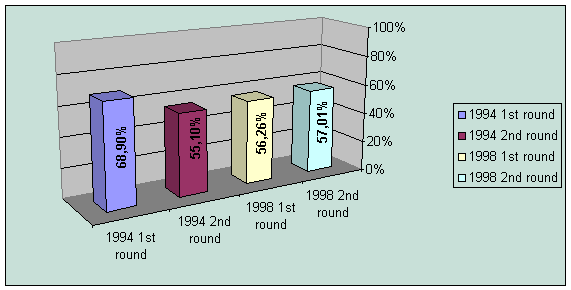|
PARLIAMENTARY ELECTIONS IN HUNGARY
1998
The Constitution of the Republic of Hungary declares that the Republic of Hungary is an independent and democratic constitutional state, where all power belongs to the people, who exercise popular sovereignty through elected representatives as well as directly.
The Constitution stipulates the date of the parliamentary election: the general election of Members of Parliament is to be held in April or May of the fourth year following the election of the previous Parliament. The President of the Republic shall set the actual date of the election.
The Act on the election of Members of Parliament, enacted in 1989, established a two-round, mixed election system in Hungary, combining elements of the single-member-constituency and the list election systems.
The Hungarian Parliament is made up of 386 members, of which 176, 152 and 58 are elected, respectively, in single-member constituencies and on the basis of the district and national lists.
Accordingly, the Hungarian electoral system is structured as follows:
- 176 single-member constituencies: the country is divided into 176 single-member constituencies, a single candidate to be elected Member of Parliament in each constituency.
- 20 district constituencies: the law has institutionalised 20 district constituencies, which cover the territory of the 19 counties and the capital. In these district constituencies, list election is held. A maximum of 152 mandates are allocated from the lists.
- National (compensatory) list: From this list, a minimum of 58 mandates are allocated in the proportion of the votes cast for those single-member party candidates who have not gained a seat and for district party lists not resulting in a seat (the two collectively referred to as ‘surplus votes’).
Hungarian citizens have two votes at the parliamentary elections. One of these votes is cast for a single-member constituency candidate, while the other is cast for the district list. No vote is cast for the national list.
Important elements of the electoral system include the mandate threshold, which essentially means that only those parties are allocated seats from the district and national lists, which have obtained more than 5 percent, on a national basis, of the valid district list votes.
The nomination system has an important additional filtering role by ensuring that only the political forces having the support of a substantial part of the society should get into Parliament.
The nomination process
1. In single-member constituencies, independent and party candidates should accumulate an equal number of at least 750 valid proposal coupons in order to be eligible.
2. A party may start a district list if it has been able to put up candidates in one-quarter of the single-member constituencies within a district, but at least in two single-member constituencies.
3. A party may start a national list if it has put up a district list in seven districts.
The system of the allocation of seats
Single-member constituencies are based on the absolute majority principle, i.e. the candidate having obtained more than half of the votes cast in the constituency shall become Member of Parliament. In the absence of such candidate, a second election round is held in that constituency. For the second election round, the law does not specify absolute majority, thus the seat is obtained by the candidate obtaining the highest number of votes.
In district constituencies, party list candidates obtain seats in the proportion of the votes cast, according to the order of the ballot-paper (fixed list). The seats are allocated by the Hagenbach-Bischoff method, provided that the lists failing to accumulate more than 5 percent of the votes cast for all party lists, totalled on a national basis, shall not be eligible.
On the national list (compensatory list), the parties are allocated seats in the proportion of their surplus votes. Surplus votes include the votes cast in single-member constituencies and not gaining a seat in either election round, and the votes cast in district constituencies – in a valid election round – which proved insufficient for a seat or which exceeded the number of votes utilised for obtaining the seat. Seats are allocated by the d’Hondt method, provided that the parties failing to reach the 5-percent parliamentary threshold shall not obtain a seat on the national list.
Results of the 1998 parliamentary elections
|
Parties
|
Single-member
constituencies
|
District
lists
|
National
list
|
Total
|
Percentage
of seats in Parliament
|
|
Fidesz
MDF
|
50
|
|
|
50
|
12.95%
|
|
Fidesz
|
55
|
48
|
10
|
113
|
29.27%
|
|
INDEPENDENT
SMALLHOLDERS’ PARTY
|
12
|
22
|
14
|
48
|
12.44%
|
|
HUNGARIAN JUSTICE
AND LIFE PARTY
|
|
3
|
11
|
14
|
3.63%
|
|
HUNGARIAN
SOCIALIST PARTY
|
54
|
50
|
30
|
134
|
34.72%
|
|
MDF
|
2
|
|
|
2
|
0.52%
|
|
SZDSZ
|
2
|
5
|
17
|
24
|
6.22%
|
|
Independent
|
1
|
|
|
1
|
0.25%
|
|
Total
|
176
|
128
|
82
|
386
|
100.00%
|
| |
|
|
|
|
|
|
|
|
|
|
Distribution
of seats in Parliament as the result of the 1998 parliamentary
elections

Total number of Members of
Parliament: 386
Participation in the 1st and 2nd
rounds of the parliamentary elections in
1994 and 1998



|

